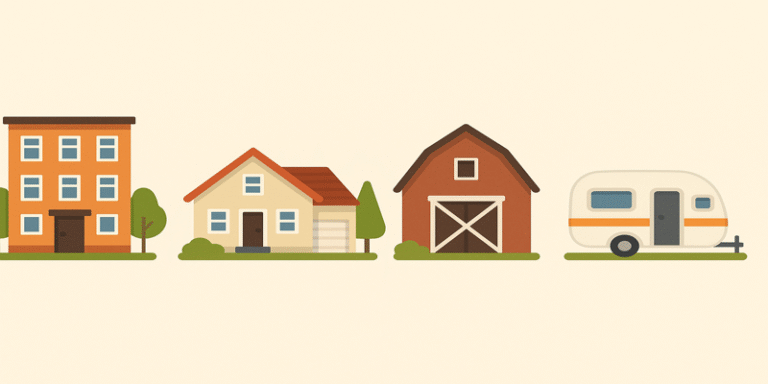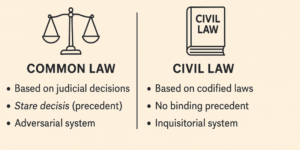Throughout history, the ways in which people construct and inhabit dwellings—whether as a home, house, flat, cottage, villa, lodge, court, crescent, or even palace—reflect cultural values, economic needs, environmental conditions, and architectural traditions. Let’s explore this rich tapestry of types of dwellings, weaving in insights from textbooks, journals, and authoritative online sources.
House and Home: Foundations of Shelter
At its most general, a house is a built structure intended for human habitation, while the notion of home encompasses emotional attachment, identity, and comfort beyond bricks and mortar (Sollitto, 2024). Throughout architectural scholarship, this distinction is central: dwelling versus dwelling-as-sanctuary.
Flat: Urban Living Defined
A flat is a self-contained housing unit within a larger building. In the UK—and particularly Scotland—a variant known as the cottage flat (or “four-in-a-block”) features four separate dwellings arranged in a single block, each with its own entrance directly to the outdoors, rather than via a shared staircase. This design became prevalent in the 1920s and 1930s during the “Homes fit for heroes” initiative (Scottish Government, post-First World War) (Wikipedia, 2025a).
Modern developments often include crescent-style housing—curved rows of flats and townhouses, such as the iconic Royal Crescent in Bath, which exemplifies elegant Georgian planning and urban harmony.
Cottage: The Quintessential Countryside Abode
In British tradition, a cottage refers to a small, cosy dwelling, typically located in rural or semi-rural settings, often with simple, vernacular construction (McGarry, 1976). Historically, during the feudal era, cottages were basic dwellings granted to cottagers (known as cotters) in exchange for service to a manorial lord (McGarry, 1976).
However, over time the term evolved. Modern usage emphasises charm, intimacy, and compactness rather than rural labour—whether it’s a Grade-II listed medieval cottage or a 20th-century “mock cottage” built to evoke nostalgia (Southern Living, 2018).
Farmhouse, Barn, Farmstead: Rural Roots
A farmhouse traditionally serves as the main dwelling within an agricultural setting, often accompanied by barns and ancillary outbuildings. In architectural and vernacular studies, a farmstead (or country grouping of buildings) includes the farmhouse, barns, stables, and sometimes a courtyard—forming a self-contained rural economy (Corradi, 2020).
In certain estates, a lodge might stand at the entrance—serving historically as a gatehouse or keeper’s residence—marking the transition from public to private land, a feature still seen in British country estates today.
Ranch: Sprawling Simplicity
The ranch-style house (commonly known simply as a ranch) originated in the United States, characterised by its single-storey layout, long horizontal profile, open plan, and integration with outdoor living spaces (Salant, 2006). Variants include the raised ranch, split-level ranch, and California ranch, among others (Wikipedia, 2025b).
Ranch houses gained immense popularity in the post-war era, especially between the 1940s and 1970s. Today, they remain culturally iconic and are even experiencing a revival among younger generations who appreciate their informal, indoor-outdoor comfort (Salant, 2006).
Bungalow, Split-level, I-House: Diverse Typologies
The bungalow is a typically single- or one-and-a-half-storey house, often with a veranda and rooted in the Bengal “bangla” vernacular form; it became especially popular during the Arts and Crafts movement (Powell, 2004).
A split-level house emerged mid-20th century, featuring staggered floors connected by short flights of staircases; this design optimises spatial division while retaining a compact footprint (Wikipedia, 2025c).
The I-house is another vernacular form, characterised by a simple two-storey, one-room-deep, multiple-rooms-wide layout, commonly seen in rural contexts of early-modern England and colonial North America (Wikipedia, 2025c).
In contrast, a villa traditionally represents luxurious countryside living—originating in Roman antiquity as a rural retreat for the elite, later adapted into Victorian and Edwardian villas found in British suburbs, combining elegance with domestic comfort.
Hall-and-Parlour: Colonial Simplicity
The hall-and-parlour house, common in early-modern England and colonial America, featured a two-room configuration—one being a communal hall and the other a more private parlour (often a sleeping area). In colonial America, it became known as the “Virginia style,” typically timber-framed with steep side-gabled roofs (Wikipedia, 2025d).
Castle, Palace: Grandeur Defined
At the other end of the spectrum lie castles and palaces—symbolic edifices of power, monarchy, or nobility. Castles were originally defensive fortifications constructed in the medieval period, while palaces are designed to exhibit grandeur, ceremonial space, and wealth.
Some historic courts—such as Hampton Court Palace—blend fortified architecture with stately domestic life, bridging the functional and the regal. They stand as monuments rather than merely dwellings, yet remain vital to our architectural vocabulary.
Diverse Styles: A Global Perspective
Beyond typological forms, architectural styles further enrich these categories:
- Georgian architecture (c. 1714–1830) emphasised symmetry, classical proportion, and brick or stone facades, epitomised in country houses, townhouses, and crescent terraces of Bath or London (Summerson et al., 2003).
- Popular domestic styles in the USA include Cape Cod, Craftsman, Farmhouse, Ranch, Cottage, Tudor, Victorian, Colonial, Greek Revival, and Modern/International—each possessing defining features such as steep gables, decorative beams, symmetrical facades, or open plans (Better Homes & Gardens, 2020; Redfin, 2025; Southern Living, 2018).
Why These Terms Matter
In architectural discourse, terms like ranch, bungalow, cottage, flat, villa, and farmhouse serve dual functions: they guide consumers in real estate, and also influence cultural identity, heritage preservation, and aesthetic expectations (Hubka, 2014). Yet, as scholars note, many dwellings defy neat categorisation—hybrid styles and renovations blur stylistic boundaries (PHMC, 2025).
Summary
- Flat: urban dwelling unit, e.g. a Scottish cottage flat with own entrances or a crescent terrace of flats (Wikipedia, 2025a).
- Cottage: small, cosy, tradition-rooted rural home, evolving over time (McGarry, 1976).
- Farmhouse / Barn / Farmstead / Lodge: rural ensemble of dwelling and work buildings, often including a gate lodge (Corradi, 2020).
- Ranch: low-profile, single-storey modern home with open layout and outdoor integration (Redfin, 2025).
- Villa: elegant suburban or country residence, combining comfort and status.
- Court: historic or stately residential complex, such as Hampton Court.
- Bungalow, Split-level, I-House, Hall-and-Parlour: vernacular typologies with specific layouts and regional histories (Wikipedia, 2025c; Wikipedia, 2025d).
- Georgian style: formal architectural style influencing grand houses, crescent rows, and terraces (PHMC, 2025).
- Castle / Palace: monumental dwellings symbolic of power and ceremonial use.
- Style-based categories: vernacular and revival styles like Cottage, Craftsman, Tudor, Modern enrich descriptive taxonomy (Southern Living, 2018).
References
Better Homes & Gardens (2020) 17 Popular Exterior House Styles. Available at: https://www.bhg.com/home-improvement/exteriors/curb-appeal/popular-housing-styles-explained/?utm_source=chatgpt.com (Accessed: 10 August 2025).
Corradi (2020) Types of country houses: Cottages, farmsteads and farmhouses. Available at: https://www.corradi.eu/en/magazine/types-country-houses?utm_source=chatgpt.com (Accessed: 10 August 2025).
Hubka, T.C. (2014) Houses Without Names: Architectural Nomenclature and the Classification of America’s Common Houses. Available at: https://www.jstor.org/stable/10.1525/tph.2014.36.1.108?utm_source=chatgpt.com (Accessed: 10 August 2025).
McGarry, D.D. (1976) Medieval history and civilization. Available at: https://en.wikipedia.org/wiki/Cottage?utm_source=chatgpt.com (Accessed: 10 August 2025).
PHMC (2025) Architectural Styles Categories. Available at: https://www.phmc.state.pa.us/portal/communities/architecture/styles/categories.html?utm_source=chatgpt.com (Accessed: 10 August 2025).
Powell, J. (2004) Bungalow Details: Exterior. Available at: https://en.wikipedia.org/wiki/Bungalow?utm_source=chatgpt.com (Accessed: 10 August 2025).
Redfin (2025) The Most Sought-After House Styles. Available at: https://www.redfin.com/blog/what-are-the-most-popular-home-styles/?utm_source=chatgpt.com (Accessed: 10 August 2025).
Salant, K. (2006) The Ranch, an Architectural Archetype Forged on the Frontier. The Washington Post. Available at: https://en.wikipedia.org/wiki/Ranch-style_house?utm_source=chatgpt.com (Accessed: 10 August 2025).
Sollitto, N. (2024) Types of Homes: An Overview of Dwellings and Styles. Century Communities. Available at: https://www.centurycommunities.com/the-front-porch/types-of-homes-an-overview/?utm_source=chatgpt.com (Accessed: 10 August 2025).
Southern Living (2018) What Really Makes A House A Cottage?. Available at: https://www.southernliving.com/home/cottage-home?utm_source=chatgpt.com (Accessed: 10 August 2025).
Summerson, J., Watkin, D. and others (2003) Georgian Architecture. Available at: https://en.wikipedia.org/wiki/Georgian_architecture?utm_source=chatgpt.com (Accessed: 10 August 2025).
Wikipedia (2025a) Cottage flat. Available at: https://en.wikipedia.org/wiki/Cottage_flat?utm_source=chatgpt.com (Accessed: 10 August 2025).
Wikipedia (2025b) Ranch-style house. Available at: https://en.wikipedia.org/wiki/Ranch-style_house?utm_source=chatgpt.com (Accessed: 10 August 2025).
Wikipedia (2025c) List of house types. Available at: https://en.wikipedia.org/wiki/List_of_house_types?utm_source=chatgpt.com (Accessed: 10 August 2025).
Wikipedia (2025d) Hall and parlor house. Available at: https://en.wikipedia.org/wiki/Hall_and_parlor_house?utm_source=chatgpt.com (Accessed: 10 August 2025).









